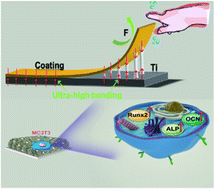In situ titanium phosphate formation on a titanium implant as ultrahigh bonding with nano-hydroxyapatite coating for rapid osseointegration†
Abstract
Titanium (Ti) has been widely used as a dental implant material due to its excellent mechanical property and good biocompatibility. However, its poor biological activity severely limits its ability to bond with bony tissues. To ameliorate this situation, a preparation method of ultra-high bonding nano-hydroxyapatite (n-HA) coating on the Ti surface is urgently needed. Here, Ti phosphate/n-HA (TiP–Ca) composite coatings with ultra-high bonding were prepared by a two-step hydrothermal treatment. The TiP coating was first formed in situ on the pure Ti substrate and then n-HA crystals further grew on the TiP surface. The formation mechanism of composite coating and reasons for increased bonding strength were systematically investigated. The results show that the TiP–Ca coating remains stable and exhibits an ultra-high bonding strength with the Ti implant (up to 783.30 ± 207.46 N). An effective solution was designed to address the problems of easy peel off. Cell experiments showed that TiP–Ca could promote the adhesion of MC3T3-E1 and expression of OCN, Runx2, and ALP. In vivo evaluation further confirmed that the TiP–Ca composite coating significantly enhanced osseointegration. The designed coating shows great potential in clinical application of implants.



 Please wait while we load your content...
Please wait while we load your content...